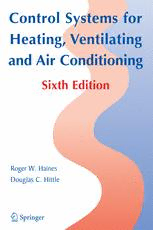
Control Systems for Heating, Ventilating, and Air Conditioning PDF
Preview Control Systems for Heating, Ventilating, and Air Conditioning
CONTROL SYSTEMS FOR HEATING, VENTILATING, AND AIR CONDITIONING SIXTH EDITION CONTROL SYSTEMS FOR HEATING, VENTILATING, AND AIR CONDITIONING SIXTH EDITION Roger W. Haines Consultant Laguna Woods, CA Douglas C. Hittle Director, Solar Energy Applications Laboratory Colorado State Universiw Ft. Collins, CO - Springer Roger W. Haines Consultant Laguna Woods, CA Douglas C Hittle Director, Solar Energy Applications Laboratory Colorado State University Ft. Collins, CO Control Systems for Heating, Ventilating, and Air Conditioning, Sixth Edition Library of Congress Control Number: 2005936096 ISBN 0-387-30521-1 e-ISBN 0-387-30633-1 ISBN 978-0-387-30521-9 Printed on acid-free paper. First Softcover Edition ©2006 © 2003 Springer Science+Business Media, Inc. All rights reserved. This work may not be translated or copied in whole or in part without the written permission of the publisher (Springer Science+Business Media, Inc., 233 Spring Street, New York, NY 10013, USA), except for brief excerpts in connection with reviews or scholarly analysis. Use in connection with any form of information storage and retrieval, electronic adaptation, computer software, or by similar or dissimilar methodology now know or hereafter developed is forbidden. The use in this publication of trade names, trademarks, service marks and similar terms, even if the are not identified as such, is not to be taken as an expression of opinion as to whether or not they are subject to proprietary rights. Printed in the United States of America. 9 8 7 6 5 4 3 2 1 springer.com Contents Contents README first please Chapter 1 Control Theory and Terminology 1.1 INTRODUCTION 1.2 WHAT IS "CONTROL"? 1.3 ELEMENTARY CONTROL SYSTEM 1.4 PURPOSES OF CONTROL 1.5 CONTROL ACTION 1.6 ENERGY SOURCES FOR CONTROL SYSTEMS 1.7 MEASUREMENT 1.8 SYMBOLS AND ABBREVIATIONS 1.9 PSYCHROMETRICS 1.10 RELATIONSHIPS 1.11 SUMMARY Chapter 2 Pneumatic Control Devices 2.1 INTRODUCTION 2.2 PNEUMATIC CONTROL DEVICES 2.3 CONTROL CABINETS 2.4 AIR SUPPLY Chapter 3 Electric and Electronic Control Devices 3.1 ELECTRIC CONTROL DEVICES 3.2 ELECTRONIC CONTROL DEVICES vi Contents Chapter 4 Fluidic Control Devices 4.1 INTRODUCTION 4.2 WALL ATTACHMENT DEVICES 4.3 TURBULENCE AMPLIFIERS 4.4 VORTEX AMPLIFIERS 4.5 RADIAL JET AMPLIFIER 4.6 FLUIDIC TRANSDUCERS 4.7 MANUAL SWITCHES Chapter 5 Flow Control Devices 5.1 DAMPERS 5.2 STEAM AND WATER FLOW CONTROL VALVES Chapter 6 Elementary Control Systems 6.1 INTRODUCTION 6.2 OUTSlDE AIR CONTROLS 6.3 AIR STRATIFICATION 6.4 HEATING 6.5 COOLING COILS 6.6 HUMIDITY CONTROL 6.7 DEHUMIDIFIERS 6.8 STATIC PRESSURE CONTROL 6.9 ELECTRIC HEAT 6.10 GAS-FIRED HEATERS 6.11 OIL-FIRED HEATERS 6.12 REFRIGERATION EQUIPMENT 6.13 FIRE AND SMOKE CONTROL 6.14 ELECTRICAL INTERLOCKS 6.15 LOCATION OF SENSORS 6.16 SUMMARY Chapter 7 Complete Control Systems 7.1 INTRODUCTION 7.2 SINGLE-ZONE SYSTEMS 7.3 MULTIZONE AIR HANDLING SYSTEMS DUAL-DUCT SYSTEMS Contents vii 7.5 VARIABLE-VOLUME SYSTEMS 7.6 REHEAT SYSTEMS 7.7 HEAT RECLAIM 7.8 FAN-COIL UNITS 7.9 INDUCTION SYSTEMS 7.10 UNIT VENTILATORS 7.11 PACKAGED EQUIPMENT 7.12 OTHER PACKAGED EQUIPMENT 7.13 RADIANT HEATING AND COOLING 7.14 RADIATORS AND CONVECTORS 7.15 HEAT EXCHANGERS 7.16 SOLAR HEATING AND COOLING SYSTEMS 7.17 SUMMARY Chapter 8 Electric Control Systems 8.1 INTRODUCTION 8.2 ELECTRIC CONTROL DIAGRAMS 8.3 ELECTRICAL CONTROL OF A CHILLER 8.4 ELECTRICAL CONTROL OF AN AIR HANDLING UNIT 8.5 EXAMPLE: A TYPICAL SMALL AIR- CONDITIONING SYSTEM 8.6 ELECTRIC HEATERS 8.7 REDUCED-VOLTAGE STARTERS 8.8 MULTISPEED STARTERS 8.9 VARIABLE SPEED CONTROLLERS 8.10 SUMMARY Chapter 9 Special Control 9.1 INTRODUCTION 9.2 CLOSE TEMPERATURE AND/OR HUMIDITY CONTROL 9.3 CONTROLLED ENVIRONMENT ROOMS FOR TESTING 9.4 SUMMARY viii Contents Chapter 10 Digital and Supervisory Control Systems 10.1 INTRODUCTION HARD-WIRED SYSTEMS MULTIPLEXING SYSTEMS COMPUTER-BASED SYSTEMS FOR MONITORING AND CONTROL BENEFITS OF THE COMPUTER SYSTEM TRAINING FOR MAINTENANCE AND OPERATION SUMMARY Chapter 11 Psychrometrics 11.1 INTRODUCTION 11.2 PSYCHROMETRIC PROPERTIES 11.3 PSYCHROMETRlC TABLES 11.4 PSYCHROMETRIC CHARTS 11.5 PROCESSES ON THE PSYCHROMETRIC CHART HVAC CYCLES ON THE CHART IMPOSSIBLE PROCESSES EFFECTS OF ALTITUDE SUMMARY Chapter 12 Central Plant Pumping and Distribution Systems INTRODUCTION DIVERSITY CONSTANT FLOW SYSTEMS VARIABLE FLOW SYSTEMS DISTRIBUTION SYSTEMS BUILDING INTERFACES SUMMARY Contents ix Chapter 13 Retrofit of Existing Control Systems 315 13.1 INTRODUCTION 315 13.2 ECONOMIC ANALYSIS 315 13.3 DISCRIMINATORS 316 13.4 CONTROL MODES 3 16 13.5 ECONOMY CYCLE CONTROLS 3 16 13.6 SINGLE-ZONESYSTEMS 3 16 13.7 REHEAT SYSTEMS 3 17 13.8 MULTIZONE SYSTEMS 320 13.9 DUAL-DUCT SYSTEMS 323 13.10 SYSTEMS WITH HUMIDITY CONTROL 328 13.1 1 CONTROL VALVES AND PUMPING ARRANGEMENTS 329 13.12 SUMMARY 33 1 Chapter 14 Dynamic Response and Tuning 332 14.1 INTRODUCTION 332 14.2 DYNAMIC RESPONSE 333 14.3 TUNING HVAC CONTROL LOOPS 334 14.4 SUMMARY 342 Bibliography 343 Abbreviations Used in This Book 348 Symbols Used in This Book 349 Index 359 README first, please This book is intended to provide guidance to engineers who are designing controls for heating, ventilating and air-conditioning (HVAC) systems and to those who maintain and trouble shoot these systems. Since our last edition, the industry has seen a major transition from analog pneumatic control to digital electronic control. New systems are often a mix of digital controllers with pneumatic actuation, especially if big valves or damper actuators are involved. Simultaneously, all electronic systems have piggy backed on the ever expanding networking technology in buildings (and beyond) and offer expanded control options. We have tried to highlight this in a revised chapter 10. Designers of new systems are referred to chapters 6,7, and 10. Another issue of heightend concern is indoor air quality. Chapter 6 discusses how outdoor air control can insure that the requirements of ASHRAE Standard 62 can be met. Achieving good environmental control in buildings requires a well designed and comrnisssioned HVAC system. The control system makes or breaks the design. We hope our book will provide useful information to practioners, especially those new to our profession.
